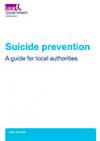It goes without saying each and every suicide that takes place is a tragedy. On average in England 13 people take their own lives every day.
This affects their families, their friends and people they work and live with. For every death, another six to 60 people are thought to be affected directly. Relationships break down, careers suffer and mental health worsens.
Our public health remit means we have responsibility for addressing many of the risk factors, such as alcohol and drug misuse, while our wider responsibilities for housing and local growth mean we can have an impact on the wider determinants.
Councils have been active on suicide prevention work in recent years. Following the publication of the 2012 strategy, councils were given the responsibility of developing local suicide action plans through their work with health and wellbeing boards (HWBs). A deadline of 2017 was set and by the end of 2016, 95 per cent of areas had plans in places or were in the process of drawing them up.
But this is just the start of the work. We now have to do the hard bit – ensure suicide rates are driven down and lives saved.
Key statistics
- there were 4,820 deaths from suicide registered in England in 2015
- for every person who dies, between six and 60 are thought to be directly affected
- three in four deaths by suicide are by men
- the highest suicide rate in England is among men aged 45 to 49
- men living in the in the most deprived areas are 10 times more at risk of suicide than those living in the most affluent areas.

- Published by:
-
LGA
- Reference code:
-
1.37
